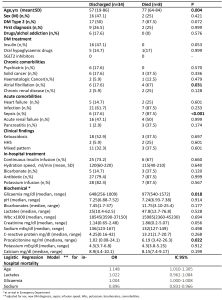Introduction: Diabetic ketoacidosis (DKA) and hyperosmolar hyperglycaemic state (HHS) are the most severe hyperglycaemic emergencies. Mortality ranges from <1% in case of DKA in young adults up to 20% for HHS in frail older patients. The aim of our study is 1) to describe the clinical characteristics of patients admitted to our department with a diagnosis of DKA or HHS and 2) to identify possible predictors of in-hospital mortality. Materials and methods: An observational retrospective single-center study was conducted on patients admitted to the Subintensive Unit of the Regional University Hospital of Ancona from January 1st, 2014, to December 31st, 2023. Medical records were accessed to collect data. A descriptive analysis and a logistic regression model were performed. Results: The analysis was conducted on 42 patients. There were 42.9% men (n=18), 26.2% did not have a previous diagnosis of diabetes (n=11), while 38% were already on insulin treatment (n=16). In the whole sample, 21 patients met the criteria for DKA (50%), 7 patients (16.7%) for HHS, while 14 patients (33.3%) presented mixed pattern (figure). In total, 8 patients (19%) died, 3 in the DKA group (14.3%), 2 in the HHS group (28.5%) and 3 in the mixed pattern group (21.4%), respectively (p=0.680). A difference between those who died and others was found for age (median, range of 57, 19-86 and 77,64-84 respectively; p=0.004), history of atrial fibrillation (17.6% vs 67%, p=0.031), the presence of sepsis (17.6% vs 87.5%, p<0.001), glycaemic values at admission (648 mg/dl, 256-1009, vs 977 mg/dl, 540-1572; p=0.018) and procalcitonin levels (1.02 ng/ml, 0.08-24.1, vs 6.19 ng/ml, 3.42-26.3; p=0.022). No differences were observed for other acute diseases or in-hospital treatment. The logistic regression model adjusted for multiple variables showed an association between death and age (OR 1.148, 95%CI 1.010-1.305, p=0.034) and an inverse association with sodium (OR 0.896, 95%CI 0.831-0.966, p=0.04). Conclusion: DKA and HHS are uncommon but severe acute complication of diabetes. These conditions can be the first manifestation of diabetes mellitus. An early recognition of the clinical pattern and the underlying triggers allows a prompt and more efficient treatment, improving the clinical outcomes.


